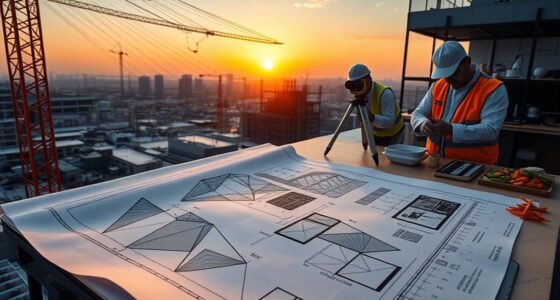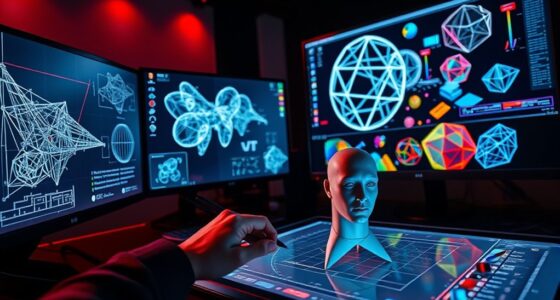Careers that use geometry span many fields, from surveyors mapping land boundaries to game designers creating realistic virtual worlds. Architects and engineers rely on geometric calculations for building structures, while urban planners design safe, functional cities. Artists, interior designers, and animators use geometry to craft balanced, visually appealing spaces and models. Robotics, forensics, and crime scene investigators also depend on it for precision and analysis. Keep exploring to discover how these careers connect through the power of geometry.
Key Takeaways
- Many careers, such as surveyors, cartographers, and urban planners, rely on geometry for land measurement, mapping, and spatial analysis.
- Architects, civil engineers, and mechanical engineers use geometry to design structures, analyze stability, and develop accurate blueprints.
- Creative fields like art, interior design, and game development apply geometric principles for proportions, perspective, and realistic modeling.
- Robotics, automation, and game developers utilize geometry for movement algorithms, spatial reasoning, and creating immersive virtual environments.
- Forensic investigators use geometry to reconstruct crime scenes, analyze evidence, and visualize spatial relationships.
Surveyors and Geospatial Analysts
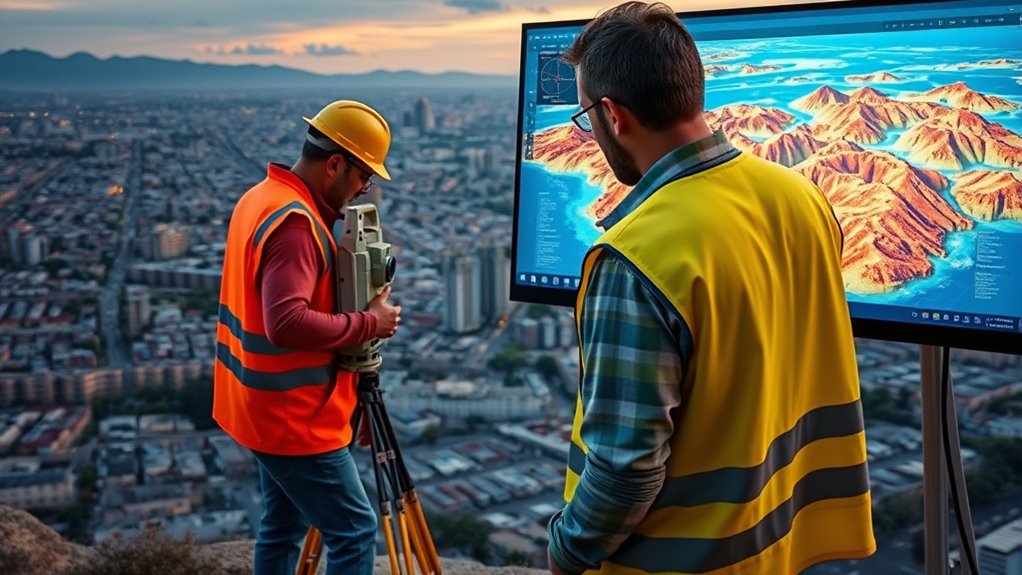
Have you ever wondered how maps are created or boundaries are accurately delineated? As a surveyor or geospatial analyst, you use your skills in topographic mapping to capture the land’s features and elevation changes. Your work involves collecting precise data through field surveys and remote sensing, which helps in creating detailed, accurate maps. Land boundary determination is a key part of your job, ensuring property lines are correctly established for legal and development purposes. You rely on advanced tools like GPS, total stations, and GIS software to analyze and interpret spatial information. Your expertise ensures that boundaries are clear and well-defined, preventing disputes. In this role, your understanding of geometry directly impacts land planning, construction, and resource management. Incorporating industry trends can further enhance the accuracy and efficiency of your work.
Architects and Civil Engineers

Ever wonder how architects and civil engineers use geometry to bring their designs to life? They rely on architectural drafting to create precise blueprints, ensuring every element fits perfectly. Geometry helps them calculate angles, lengths, and areas, making sure structures are both functional and aesthetically pleasing. Civil engineers perform structural analysis to assess how buildings and bridges will withstand forces like gravity and wind. This involves applying geometric principles to test stability and safety. By understanding geometric relationships, you can accurately develop plans, identify potential issues, and optimize materials. Whether designing a skyscraper or a roadway, geometry is the foundation that transforms creative ideas into real-world structures you can see and use every day. Additionally, tools like hot rollers can be used to style hair efficiently, demonstrating how practical applications of geometry extend beyond engineering and architecture.
Urban and Regional Planners
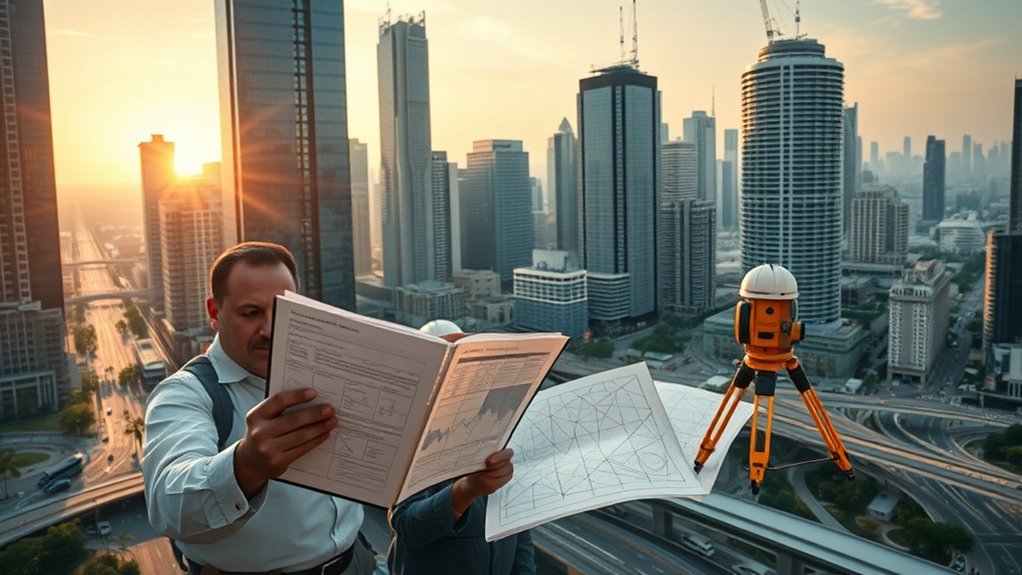
Urban and regional planners use geometry to design efficient and sustainable cities. You apply geometric principles to analyze urban growth patterns, optimize land use, and develop zoning regulations that balance development and green spaces. Your work guarantees cities expand thoughtfully, preventing congestion and environmental harm. By creating accurate maps and spatial models, you help guide infrastructure placement and transportation networks. Understanding geometric relationships allows you to set zoning boundaries that accommodate diverse communities while maintaining safety and accessibility. Your expertise helps shape cityscapes that are functional, resilient, and sustainable. Geometric relationships play a crucial role in developing effective urban planning strategies.
Digital Game Developers and Animators

As a digital game developer or animator, you use geometry to create realistic 3D models and immersive virtual environments. You also apply geometric algorithms to guarantee smooth movement and interactions within the game. Mastering these skills helps bring your creative ideas to life. A solid understanding of high refresh rates ensures your game visuals remain crisp and responsive during fast-paced action.
Creating 3D Models
Creating 3D models is a fundamental skill for digital game developers and animators, allowing you to bring characters, environments, and objects to life in virtual worlds. You’ll use mathematical modeling and geometry in art to craft realistic and visually appealing assets. Precise understanding of shapes, proportions, and spatial relationships helps guarantee your models look believable from every angle. Mastering these skills allows you to add textures, details, and animations that enhance immersion. To deepen your knowledge, consider exploring:
- The role of symmetry in model creation
- Techniques for optimizing polygon count
- Applying geometric transformations
- Incorporating mathematical algorithms for realism
- Using geometry to mimic natural forms in art
This foundation enables you to create compelling, accurate 3D representations crucial for engaging digital experiences.
Designing Virtual Environments
Mastering geometry skills from 3D modeling provides a strong foundation for designing compelling virtual environments. You use mathematical modeling to create realistic spaces, ensuring objects and landscapes fit together seamlessly. Geometry helps you define spatial relationships, making environments believable and engaging. When developing virtual reality experiences, precise geometric calculations enhance immersion, allowing users to navigate smoothly. You optimize geometry to balance visual detail with performance, ensuring environments load efficiently without sacrificing realism. By understanding geometric principles, you can craft environments that respond accurately to user interactions and physics. This combination of skills enables you to design virtual worlds that feel natural and captivating, whether for gaming, training simulations, or immersive storytelling. Additionally, understanding the fundamental concepts of geometry allows you to troubleshoot and refine designs effectively, resulting in more polished virtual environments. Geometry truly empowers you to bring dynamic virtual environments to life.
Applying Geometric Algorithms
Applying geometric algorithms is vital for digital game developers and animators to craft realistic and dynamic visuals. These algorithms enable complex processes like generating fractal patterns, which add intricate detail to landscapes and textures, and geometric tiling, essential for creating seamless backgrounds and environments. By leveraging algorithms, you can simulate natural phenomena or optimize rendering speeds, making scenes more immersive. Techniques such as recursive fractal algorithms produce self-similar patterns, while tiling algorithms ensure efficient use of space without gaps. Understanding how to implement these algorithms allows you to develop visually stunning worlds that feel authentic and alive. Mastery of geometric algorithms transforms simple shapes into complex, engaging visuals that captivate players and viewers alike. Additionally, spatial reasoning is fundamental in designing algorithms that efficiently manipulate geometric data for real-time rendering.
Interior Designers and Decorators
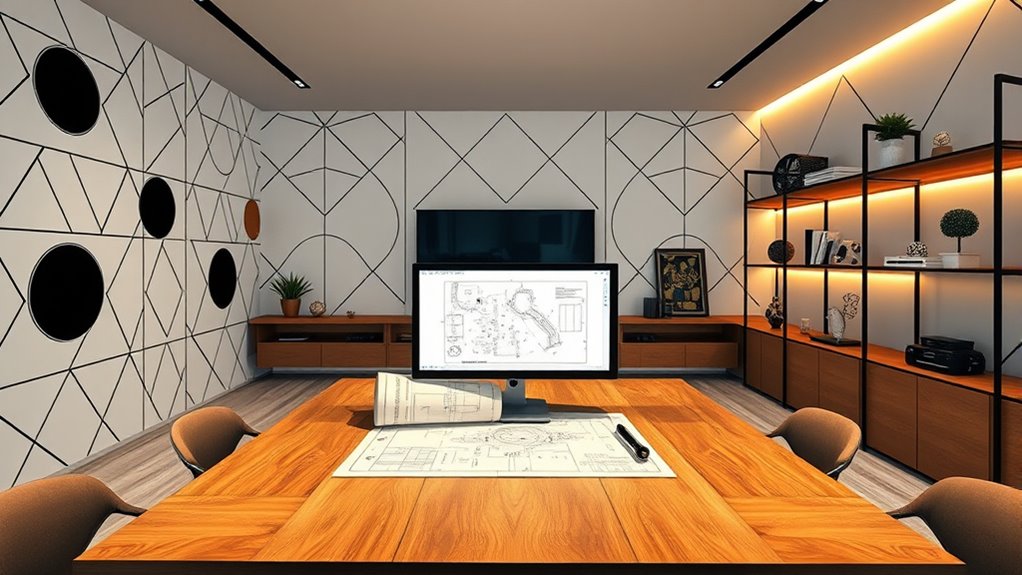
Have you ever wondered how interior designers and decorators transform spaces into harmonious environments? They use geometry to master space planning, ensuring furniture fits perfectly and rooms feel balanced. Color harmony is equally important; they select palettes that evoke specific moods and unify elements. Geometry guides the proportions and placement of decor, making a room feel cohesive and functional. To illustrate, here’s a simple layout:
| Space Element | Geometric Principle | Purpose |
|---|---|---|
| Sofa | Symmetry | Balance |
| Rug | Proportionality | Visual harmony |
| Windows | Angles | Light flow |
| Wall Art | Alignment | Focus and flow |
Mastering these geometric concepts helps create inviting, well-organized interiors that reflect style and purpose. Understanding spatial relationships is crucial for achieving a harmonious design.
Mechanical and Aerospace Engineers
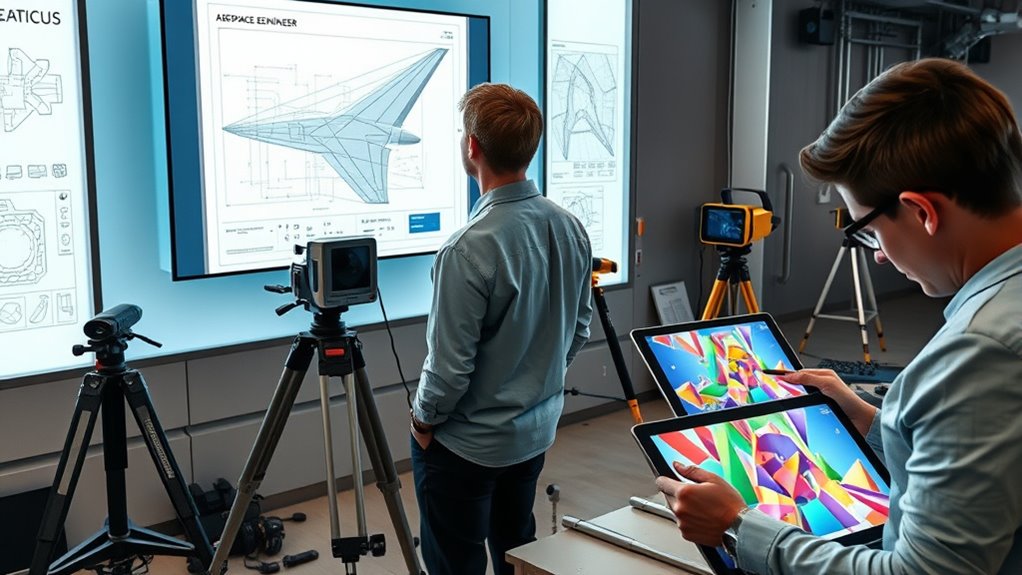
Mechanical and aerospace engineers rely heavily on geometry to design, analyze, and optimize complex systems. Your work involves precise calculations for aerospace navigation, ensuring aircraft follow accurate routes. You’ll use geometry to develop mechanical component design, creating parts that fit perfectly and function reliably. Understanding angles, shapes, and spatial relationships helps you troubleshoot aerodynamic issues or mechanical failures. Geometry also guides the development of navigation systems that keep aircraft on course. By applying geometric principles, you can improve fuel efficiency, safety, and performance. Your expertise enables the creation of lightweight yet durable materials and components. Whether designing a spacecraft or an automobile, geometry is essential to translating concepts into functional, efficient systems that meet rigorous standards. Techniques from tuning Hyundai vehicles can inspire innovative approaches to precision and performance optimization in engineering design.
Robotics and Automation Specialists
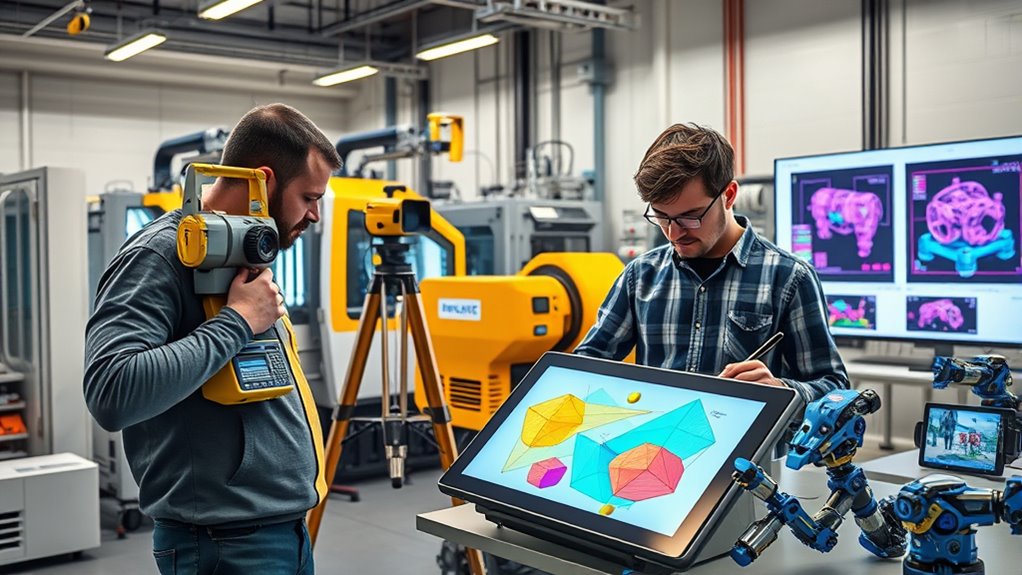
Robotics and automation specialists use geometry to design and program machines that perform precise tasks. You’ll focus on robotic arm calibration, guaranteeing each movement aligns perfectly with its intended function. Geometry helps you determine angles, distances, and trajectories, which are critical for accuracy. When designing automation pathways, you map out routes that robots follow to maximize efficiency and safety. This involves calculating the most effective angles and motions to avoid obstacles and optimize productivity. Your skills in geometry allow you to troubleshoot and refine robotic systems, guaranteeing they operate smoothly. Whether calibrating a robotic arm or designing complex movement patterns, your understanding of geometric principles ensures machines work reliably, precisely, and efficiently to meet industrial and technological needs. Additionally, an understanding of fathers’ guidance and support can be essential in collaborative team environments, fostering effective communication and problem-solving.
Forensic and Crime Scene Investigators
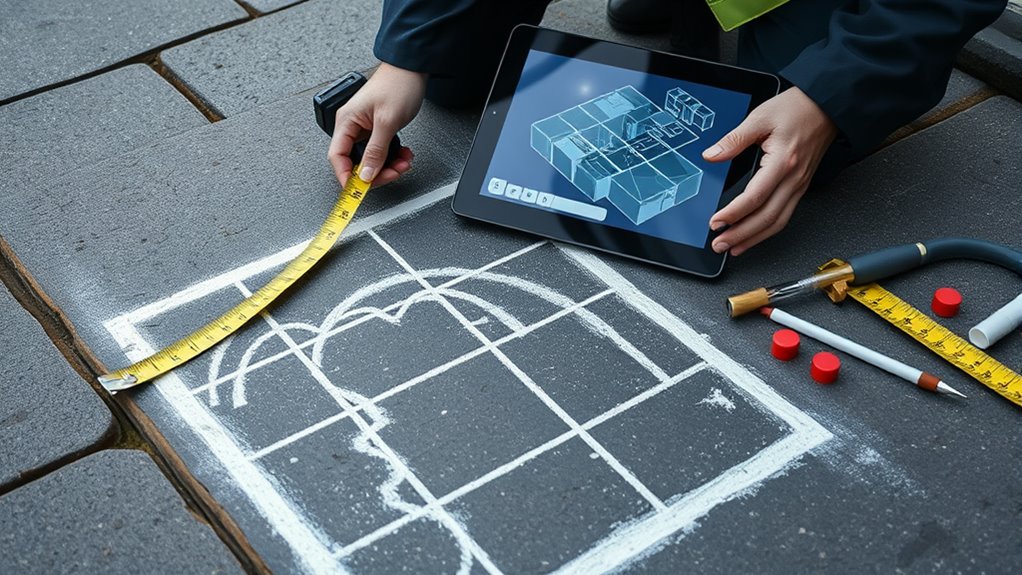
As a forensic investigator, you use geometry to reconstruct crime scenes and understand how events unfolded. You analyze evidence with precise measurements and spatial relationships to piece together the story. Your skills help guarantee that every detail is accurate and trustworthy in solving cases. Additionally, Kia Tuning techniques such as detailed measurements and component analysis can be applied to optimize vehicle performance and aesthetics.
Crime Scene Reconstruction
Have you ever wondered how investigators piece together what happened at a crime scene? Crime scene reconstruction relies heavily on geometry skills, especially in scale modeling and pattern recognition. You analyze evidence to create accurate models of the scene, helping visualize events. These models allow you to measure distances precisely and understand spatial relationships. Pattern recognition helps identify consistent clues amid chaos, like trajectories or blood spatter patterns. You use geometry to determine angles, heights, and positions, reconstructing movements and interactions. This process is essential in establishing timelines and suspect actions. Remote work can also influence how forensic teams collaborate and share findings efficiently.
- Creating 3D scale models of the scene
- Analyzing blood spatter trajectories
- Measuring distances between evidence
- Recognizing spatial patterns
- Reconstructing movement sequences
Evidence Analysis Techniques
Ever wondered how forensic experts analyze evidence to solve crimes? They rely on evidence analysis techniques that involve statistical inference and hypothesis testing. By applying statistical inference, investigators estimate the probability that evidence matches a suspect or crime scene, helping to determine its significance. Hypothesis testing allows them to evaluate different scenarios—such as whether a fingerprint found at the scene belongs to a suspect or is a random match. These methods help guarantee conclusions are scientifically valid and unbiased. Forensic analysts carefully interpret data, considering margins of error and confidence levels. Using geometry, they measure distances or angles to compare evidence accurately. Understanding the second trimester of pregnancy can also involve precise measurements, much like geometric analysis in forensic science. This combination of statistical methods and geometric analysis provides a powerful toolset for solving crimes with precision and confidence.
Art and Industrial Designers
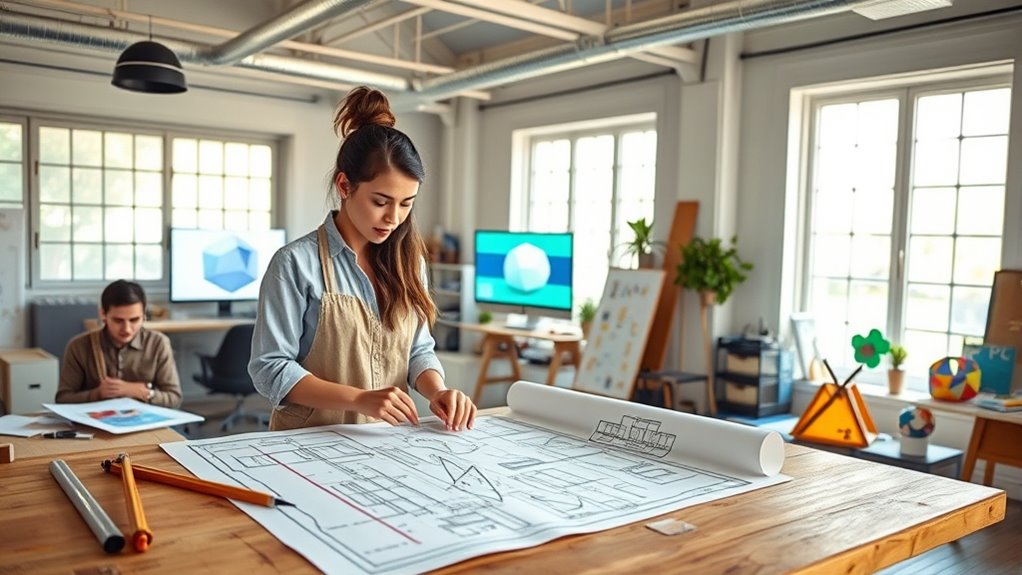
How does geometry influence the work of art and industrial designers? It shapes how you create realistic perspectives, using perspective drawing to craft depth and dimension. You rely on geometric principles to design balanced and visually appealing objects, from furniture to digital interfaces. Color theory, rooted in geometric relationships, guides your choices to evoke specific emotions or highlight features. Understanding symmetry and proportions helps you develop harmonious designs that attract and retain attention. Geometry guarantees your creations are both functional and aesthetically pleasing. Additionally, mastering for sale 100 can provide insights into market trends and consumer preferences that influence design decisions.
Frequently Asked Questions
How Does Geometry Influence Environmental Sustainability Practices in These Careers?
Geometry plays a crucial role in shaping environmental sustainability practices by enabling precise urban planning and environmental modeling. You use geometric principles to design efficient layouts, reduce waste, and minimize ecological impact. By applying geometry, you can model ecosystems, predict changes, and optimize resource use. This helps you create sustainable solutions that balance development with conservation, making your work more eco-friendly and effective in promoting long-term environmental health.
What Software Tools Are Essential for Professionals Applying Geometry Daily?
Using software tools is like having a trusty toolkit at your side. You’ll rely on CAD software for precise drawings and 3D modeling to visualize complex designs. These tools help you apply geometry daily, whether you’re drafting buildings, designing games, or analyzing landscapes. Mastering CAD and 3D modeling software makes your work more accurate and efficient, ensuring your projects meet exact specifications and stand out in quality.
How Can Students Develop Spatial Reasoning Skills for Geometry-Based Careers?
To develop your spatial reasoning skills for geometry-based careers, you should focus on visualization techniques like drawing diagrams and using 3D models. Practice mental rotation skills by imagining how objects look from different angles and manipulating shapes in your mind. Regularly challenge yourself with puzzles, CAD software, or virtual reality tools to strengthen these abilities. These strategies will help you think critically and solve complex problems effectively.
Are There Interdisciplinary Roles Combining Geometry With Other Scientific Fields?
You might think interdisciplinary roles are rare, but they’re more common than you realize. Combining geometry with fields like engineering, architecture, or computer science fuels cross-field innovations and collaborative projects. These roles foster interdisciplinary collaborations, pushing boundaries and solving complex problems. Embracing such careers means you’ll apply geometry in diverse contexts, enhancing your skills and opening unique opportunities that blend scientific disciplines for impactful, innovative solutions.
What Emerging Trends Are Shaping the Future of Geometry-Based Professions?
You’ll see that emerging trends like Augmented Reality and Artificial Intelligence are transforming geometry-based professions. You can expect these technologies to enhance spatial understanding, automate complex calculations, and create immersive experiences. As you adapt to these changes, you’ll find new opportunities in fields like architecture, gaming, and robotics. Embracing these innovations helps you stay ahead, making your skills more valuable and opening doors to exciting, future-focused careers.
Conclusion
Now that you see how geometry weaves through so many careers, it’s like a hidden thread in the fabric of innovation and creativity. Whether you’re designing a skyline, crafting a game world, or solving mysteries, geometry’s magic shapes your path. Embrace its power, and you’ll unseal endless possibilities—building, exploring, and creating worlds just waiting for your touch. Let geometry be your compass, guiding you toward a future full of endless discovery.


